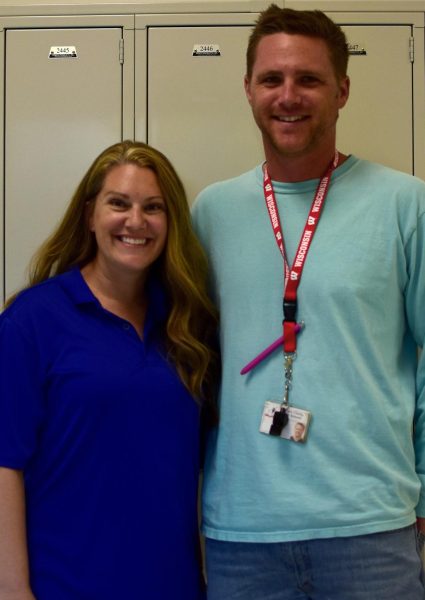
Students are expected to build a relationship with their teachers to get good college recommendations, become a better student, and ultimately to have fun in school. Everyone gets help from their teachers during office hours, but what happens when this relationship moves online?
History teacher Joseph Sheehy occasionally assumes his secondary role as Football coach online. “Just the football kids follow me on social media, and that’s mostly for an exposure-recruiting type situation,” says Sheehy. He mainly uses social media to help his athletes.
Sheehy explains, “I don’t really have social media in general outside of Twitter.”
Here lies another facet of the online student-teacher relationship: how the teachers personally use social media.
Regardless of Sheehy’s personal social media use, he sets a strict boundary between himself and his student counterparts. “It’s just good policy to keep a separate line of teacher vs. student relationship.”
Sheehy goes on to say, “The line for me would be that it is athlete related, when we interact, if we do online, like it’ll be a reposting or getting the kid in touch with a college coach or something like that.”
Sheehy is a laid back teacher, but keeps it straightforward when it comes to how he operates online with his students. “There’s not like a personal back and forth ‘what are you doing this weekend’ type thing.”
Despite this line, Sheehy continues to build a high rapport with his students. Senior Elise Krushinski says, “I’m pretty close with Mr. Sheehy.” Although Krushinski has not had Sheehy’s class, she is still able to foster a teacher-student connection with him.
“A specific group of us, a lot of girls from lacrosse, would go sit in there for the one hour lunch, and even with the “lunch and learn” he would let us sit in there. It was kind of a smaller group, but we definitely developed a close relationship with him,” she explains.
Krushinski also says, “We would get to talking about random stuff while we were in there for lunch.” Sheehy has proven social media interaction is not necessary when it comes to growing a relationship with his students.
Sheehy also maintains his boundaries with the students he doesn’t teach. “Sheehy said I’m not allowed to follow him until I graduate,” Krushinski comments.
While it may be unnecessary, contact online can help develop these relationships. Social studies teacher Sarah Jackson takes a slightly different approach when operating online.
She first explains her teaching philosophy. “They have to know you care about them. I learned pretty early on that if they had bought into me as their teacher, as somebody that made an impact in their life, that they would work for me.” Jackson ensures that her students are aware of her compassion for them as people and as kids.
Jackson does this by showing her support for their extracurriculars. “It’s a win-win that I go and see them at the activities that they participate in school. I like cheering for the kids at the sporting events or the school plays. I get just as much out of it as they do,” Jackson exclaims.
She continues to show her dedication to her students online. “I don’t ever want to post anything on Instagram that would influence their mindset so they would say, ‘Oh, Mrs. Jackson thinks that that must be true because that is what she does. She follows the news, she keeps up with what’s going on.’” It is really important to her that she doesn’t sway how her students think about politics.
Jackson also has a handful of students on her social media. “I have some field hockey players on Instagram and Emily’s friends. So, that’s been different having a high schooler here. That’s different than before. But, I would definitely not let students be friends with me on facebook.”
She continues to elaborate on the difference between the two platforms for her. “I feel like Instagram is just a picture, whereas Facebook has information. You get more of people’s personal life on facebook.”
Jackson doesn’t allow students to interact with her on Facebook because of that discrepancy in personal information between it and Instagram. “On Facebook they’re ranting about whatever is going on in their life. It is kind of like a combination of Instagram and Twitter, I guess. I just post a picture of my kids every once in a while.”
Jackson also touched on another aspect that makes it unclear on how to navigate social media with students. “The only people I’m friends with on Facebook are either kids that have traveled with me because we make facebook pages or students who have graduated,” she explains. Some teachers like Sheehy and Jackson have different roles at school, which can make relationships online a necessary aid.
Computer teacher David Tolentino agrees. “It really depends. I don’t see a problem with interacting with students online. For example, say if teachers have kids here, and then obviously they follow their families and kids.” Tolentino is not one of those teachers though, so he personally operates very strictly.
“I just think there needs to be a separation between personal life and school life.” — Tolentino
His line of professionalism crosses social media off completely between him and his current students.
“I don’t want to see what you do outside of school, but when you come back after graduating and now I see what you’ve done, that makes it less awkward,” Tolentino remarks. Part of his online philosophy is because he actively uses social media, unlike other teachers.
On the outside, teachers interacting with students online is a little sketchy. People have been tailored to think the worst of these connections because of what has happened in the past. However, there are exceptions where including social media in a teacher-student relationship makes sense. It only becomes strange when the outside platform is being used to discuss topics that are irrelevant to the participants’ roles at hand.

